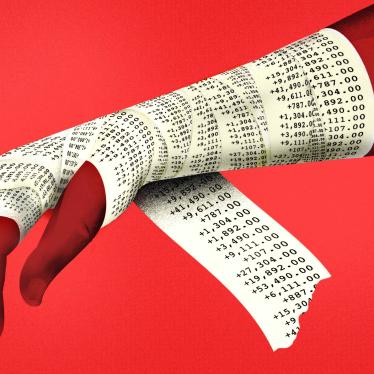The United States is in the midst of a public health crisis. More than 59,000 people died of drug overdoses in 2016, an increase of nearly 20 percent from the previous year. According to the Centers for Disease Control, 91 people die of opioid-related overdose each day, mostly from prescription painkillers, heroin, and the potent synthetic drug fentanyl. However, overdose death is often preventable if the medication naloxone is administered in time.
The Human Rights Watch report “A Second Chance: Overdose Prevention, Naloxone and Human Rights in the United States” and accompanying video examine the barriers to wider availability of naloxone, and identify steps that federal and state governments should take to save thousands of lives.
Below are questions and answers that highlight the report’s key findings and recommendations.
- What is Naloxone?
- Is naloxone a human rights issue?
- Is naloxone available in the US?
- What steps can be taken to make naloxone more available to those most likely to be at the scene of an overdose?
Naloxone is a safe, generic medication that can bring someone back to life if given in the early stages of an overdose. It works by binding to a person’s opioid receptors and displacing the opioids causing the overdose. Naloxone is available only as a prescription medication but is not a controlled substance. Easily administered by non-medical personnel, it carries no potential for abuse or misuse, and has no effect if given to someone who is not experiencing an overdose.
There is no evidence that naloxone availability increases drug use, and many programs that offer naloxone – such as syringe exchanges – have proven effective in bringing people into treatment programs.
Between 1996 and 2014, at least 30,000 overdoses have been reversed using naloxone; the real number is likely to be much higher as many cases go unreported. Naloxone is on the World Health Organization’s list of “essential medicines.”
For effective overdose prevention, the people likely to be first at the scene of an overdose – generally relatives, others who use drugs, and first responders – must have naloxone and know how to use it. Amid this nationwide public health crisis, access to naloxone is a critical lifeline.
2. Is naloxone a human rights issue?
Yes. Everyone enjoys the right to health, including people who use drugs. Numerous international agreements address what that means, including the Universal Declaration of Human Rights, the International Covenant on Civil and Political Rights and the International Covenant on Economic, Social and Cultural Rights. International bodies have specifically recognized the right of people who use drugs to comprehensive treatment and care, including overdose prevention, as a human right.
3. Is naloxone available in the US?
All 50 states and the District of Columbia have recently taken steps to increase the availability of naloxone. These measures include permitting the medication to be prescribed and dispensed without the person at risk seeing a prescriber, through mechanisms known as third-party and standing order prescriptions. Most states have also passed overdose Good Samaritan laws that provide some protection from criminal liability for those who call 911 to report an overdose. The Human Rights Watch report on naloxone appendix identifies which states have passed these measures.
The federal government has made naloxone available through numerous initiatives, including Congressional funding for overdose prevention, support for law enforcement agencies to carry naloxone, and making access to naloxone a key part of the national drug control strategy. In its interim report President Donald Trump’s Commission on Combating Drug Addiction and the Opioid Crisis highlighted the importance of naloxone and made several proposals for increasing access, including requiring it to be prescribed along with all prescriptions for opioid pain medication and mandating law enforcement agencies to carry naloxone.
4. What steps can be taken to make naloxone more available to those most likely to be at the scene of an overdose?
In light of the current emergency, bolder action is necessary. Our report identifies three important steps that would widen naloxone availability in the US:
- Reduce the cost: naloxone is a generic medication that is not expensive to make. In 2005, one injectable unit cost less than $1. Since 2008, the price has increased dramatically, and now ranges from $15 (injectable format) to $3,500 or more (auto-injector format), placing it out of reach of many individuals, community groups, and public agencies. Congress and the manufacturers of naloxone should act to ensure the affordability of this medication that prevents needless overdose deaths.
- Decriminalize personal drug use and possession: criminal laws and the threat of arrest undermine a public health response to the opioid crisis in numerous ways, including limiting syringe exchange programs that are a prime site for distribution of naloxone to people who use drugs; reducing the willingness to call 911 or seek help of witnesses to an overdose; and promoting stigma and discrimination that keep people who use drugs from accessing health care services.
- Grant naloxone over-the-counter status: because naloxone requires a prescription, it is often not available at an overdose. Every state has passed legislation making naloxone easier to get, but at least one medical professional is still required because only the Food and Drug Administration (FDA) can make a drug available without a prescription. This is a barrier because many people at risk of overdose lack health insurance or fear the stigma they may experience when asking a doctor or pharmacist for naloxone. With decades of safe administration by lay people, naloxone meets the criteria for an over-the-counter medication, and the FDA should immediately conduct an expedited review with a view to exempting one or more formulations of naloxone from the prescription requirement. This simple step – making naloxone as available as Tylenol – could save thousands of lives.







